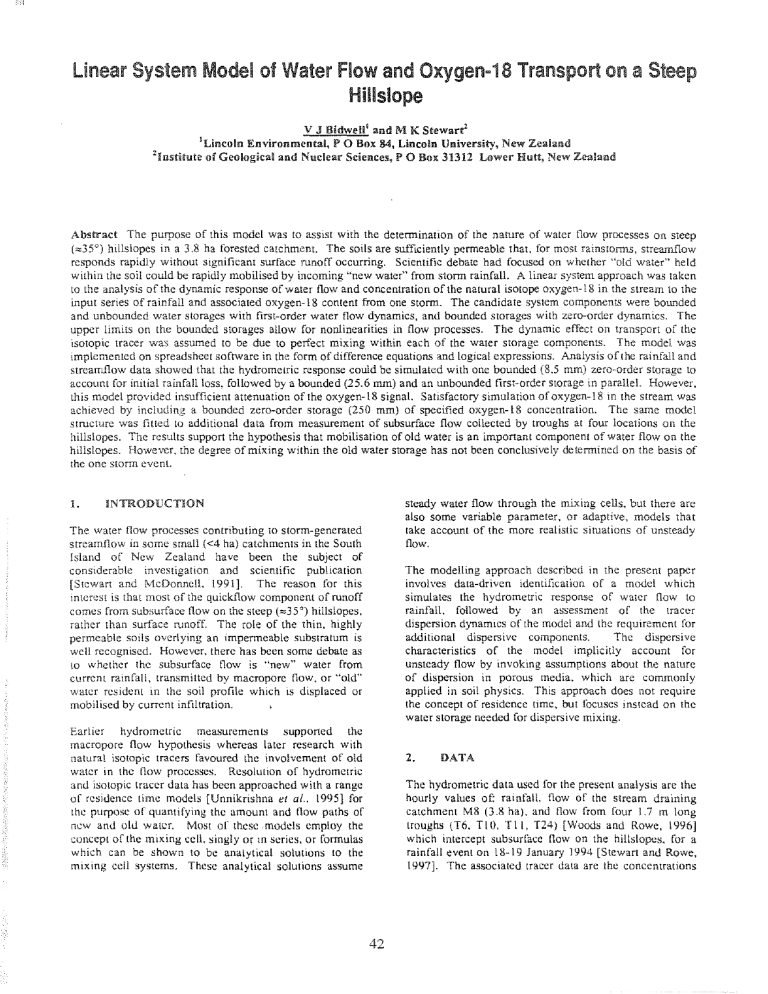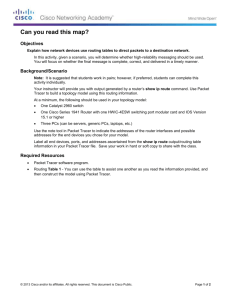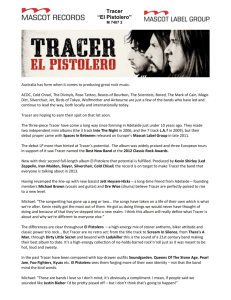linear System Model of Water Flow and Oxygen-18 Transport on... Hilisiope

linear System Model of Water Flow and Oxygen-18 Transport on a Steep
Hilisiope
V
J
Bidwell' and M K Stewart'
lLincoin
Environmental,
POBox 84,
Lincoln
University, New
Zealand
2Institute of Geological and Nuclear Sciences, POBox 31312 Lower Hutt, New Zealand
Abstract The purpose of this model was to assist with the determination of the nature of water flow processes on steep
{:::::35°) hillslopes in a 3,8 ha forested catchment. The soils are sufficiently permeable that, for most rainstorms, streamflow responds rapidly without Significant surface lUnoff occurring. Scientific debate had focused on whether "old water" held within the soil could be rapidly mobilised by incoming "new water" from stonn rainfall. A linear system approach was taken to the analysis of the dynamic response of water flow and concentration of the natural isotope oxygen-18 in the stream to the input series of rainfall and associated oxygen-18 content from one storm. The candidate system components were bounded and unbounded water storages with first-order water flow dynamics, and bounded storages with zero-order dynamics. The upper limits on the bounded storages allow for nonlinearities in flow processes. The dynamic effect on transport of the isotopic tracer was assumed to be due to perfect mixing within each of the water storage components. The model was implemented on spreadsheet software in the form of difference equations and logical expressions. Analysis of the rainfall and streamflow data showed that the hydrometric response could be simulated with one bounded (8.5 mm) zero-order storage to account for initial rainfall loss, followed by a bounded (25.6 rrun) and an unbounded first-order storage in parallel. However, this model provided insufficient attenuation of the oxygen-I 8 signal. Satisfactory simulation of oxygen-l 8 in the stream was achieved by including a bounded zero-order storage (250 mm) of specified oxygen-18 concentration. The same model structure was fItted to additional data from measurement of subsurface flow conected by troughs at four locations on the hillslopes. The results support the hypothesis that mobilisation of old water is an important component of water flow on the hillslopes. However, the degree of mixing within the old water storage has not been conclusively determined on the basis of the one storm event.
1.
INTRODUCTION
The water flow processes contributing to storm-generated streamflow in some smaH «4 ha) catchments in the South
Island of New Zealand have been the subject of considerable investigation and scientific publication
[Stewart and McDonnell. 1991]. The reason for this interest is that most of the quickflow component of runoff comes from subsurface flow on the steep (:::::35°) hillslopes, rather than surface runoff. The role of the thin. highly permeable soils overlying an impermeable substratum is well recognised. However, there has been some debate as to whether the subsurface flow IS "new" water from current rainfai!, transmitted by macropore flow. or "old" water resident in the soil profile which is displaced or mobilised by current infiltration.
Earlier hydrometric mea,surements supported the macropore flow hypothesis whereas later research with natural isotopic tracers favoured the involvement of old water in the flow processes. Resolution of hydrometric and isotopic tracer data has been approached with a range of residence time models [Unnikrishna el al .. 1995] for the purpose of quantifying the amount and flow paths of new and old water. Most of these models cmploy the concept of the mixing cell. singly or III series. or formulas which can be shown to be analytical solutions to the mixing cet! systems. These analytical solutions assume steady water flow through the mixing celis, but there are also some variable parameter, or adaptive, models that take account of the more realistic situations of unsteady flow.
The modelling approach described in the present paper involves data-driven identification of a model which simulates the hydrometric response of water now 10 rainfall. followed by an assessment of the tracer dispersion dynamics of the model and the requirement for additional dispersive components. The dispersive characteristics of the model implicitly account for unsteady flow by inVOking assumptions about the nature of dispersion in porous media, which are commoniy applied in soil physics. This approach does not require the concept of residence time, but focuses instead on the water storage needed for dispersive mixing.
2. DATA
The hydrometric data used for the present analysis are the hourly values of: rainfall, flow of the stream draining catchment M8 (3.8 hal. and Oow from four
1.7
m long troughs (T6. TID. Til. T24) [Woods and Rowe. 1996] which intercept subsurface flow on the hiHslopcs. for a rainfall event on 18-19 January 1994 [Stewart and Rowe.
1997]. The associated tracer data are the concentrations
42
~I,-----------------------------,
-4.5 .
0
I ~:.=:~f~o~-oo;;~~~;:~=~~;~~~:~o~o:j
.1J .................... -.... _
-1
I I
-12
5 15 2D 25 30
Time (hours)
Figure 1: The hydrometric and oxygen-l8 tracer data for the stream M8 during the stonn of 18-19 January 1994, of the natural isotope oxygen-I8 expressed in unils of
8
18
0, the deviation from Vienna standard mean ocean water (Y-SMOW).
Figure 1 shows the hydrometric data for the rainfall and streamflow, both in unit area scale (mrn), and the corresponding oxygen-IS tracer data. The strong oxygen-I 8 signal in the rainfall is caused by precipitation from air masses with diiTerent altitudinal origins. The oxygen-IS signal in the streamflow is highly attenuated, and this behaviour prompted the present examination of dispersive processes. Figure 2 shows how the oxygen-IS concentration of the streamand trough-flows all converge to a narrow band of values. The trough flow data show a response pattern similar to the stream, but the catchment area of each trough is not well defined and therefore a gain facIOr was included in the model to achieve mass balance.
3. MODEL
3.1 Initial MOdelling Philosophy
The original approach considered for modelling the hydrometric (rainfall-streamflow) data followed that described by Jakeman and Hornberger [1993]. This involves application of time-series analysis to the rainfall
(modified for initial losses) and str~ami1ow data to identify a transfer function in the fonn of a difference equation with minimal parameterisation. A typical candidate model is the second-order difference equation representing two water storage components in parallel:
(I) v,therc Ok is streamflow and P k is precipitation excess for the kth time interval. i
L ~ T6_~
- - Tn - - T24
25 15
Time 1hours)
20
J
30
Figure 2: Oxygen-18 tracer data for flow in the stream and troughs.
The analytical techniques available
from
microCAPTAIN software [Young and Benner. 1991] were applied to the data shown in Figure], after allowing for initial losses.
The results were inconclusive. in that the "best" model. in terms of minimal parameters was first order. bUI the
fit
was unsatisfactory.
3.2 Revised Identification Technique
Firstand second-order difference equations were manually fitted to portions of the data. using spreadsheet formulas and graphics. In particular, the "modal" parameters a1 and a1 were fitted to the recessional portions of the stream110w record which appeared to be not directly influenced
by
rainfalL The initial results showed that higher flow5 could be fitted satisfactorily with
a
first-order model whereas
at
lower flows a second order model was required. This suggested the presence of nonlinear behaviour which could
be
simulated with a system of linear components that includes a method of switching between paraliel branches in response to the states of the system.
Therefore. the original philosophy was retained of identifying a linear system from the data. which is parsimonious with parameters. but in addition to the fundamental first-order components of candidate systems there was a need to include parameters to indicate switching between flow branches. It was also decided to include a component to simulate the nonlinear effect of accounting for rainfall, in the initial stage of a stonn, which does not contribute to streamflow. The candidate structural arrangements were limited to parallel and series combinations of two or three components.
43
3.3 Hydrometric Model Components
Figure 3 shows the three types of system components, with the relationships between the output water flux q and water storage contents S, with input water flux p. on a continuous time basis. The values of p, q, and Shave dimensions of flux [LY'] and storage [L] for this lumped catchment model.
Unbounded first-order
Bounded first-order p
Bounded zero-order
Figure 3: The candidate system components.
For the unbounded first-order storage, the differential equations for water balance can be expressed in the (statespace) fonn: dS
-=-as+p dt q =as
(2) and the corresponding difference equations for the kth time interval 6t arc:
Sk =
ASk~' + Bp, q == aSk
(3 ) in which:
B=(l-A)I a
(4 )
The relationship (4) between the discrete and continuous parameters assumes that qk and S .. are instantaneous values at the end of the kth interval whereas the input Pit is the average over the interval.
The bounded first-order storage has an upper limit on storage capacity, Smax, and an additional output r when
it
is full. The difference equations for this storage are:
{
AS,_, + Bp, - S""" llt
01.
, r
J
(5) and the effect is to cause diversion of water flow to another component with different d:ynamic behaviour, as a form of quasi-linearisation of flow processes.
During the time intervals when the Threshold value SmAA is
"switched" on or off, there can be a minor violation of the continuity implied by (4), but this has been ignored in the present model. Except for these intervals, rit is also the mean value over the time interval as the input to another component.
The bounded :ero-order storage has which must be filled before there is
a
capacity
SlIlaJ( any
output, after which the output q equals the input p and there is no detectable hydrodynamic behaviour. The discrete-time equations are:
Sk =
min{Sk~l
+
Pk
llt,
Smax} max{Sk_l +Pk6.t -Smax,O}' t.t
( 6)
This component can be used to simulate initial loss from stann rainfall, that does not contribute to streamflow.
3.4 Tracer Dispersion Modelling
Maximum dispersion of a tracer which transits any of the above water storage components is achieved by
assuming
that the
incoming tracer is instantaneousLY
mixed
into
the whole contents. The outgoing tracer concentration is the same as that in the storage. Lesser degrees of dispersion can be simulated by subdividing the water storage into smaller mixing volumes in series through which the water flows. This concept is the basis of the mixing cell model of advective-dispersivc solute transport (e.g., Bidwell,
1997}. For the present model. the maximum dispersion case is considered in order to calculate the minimum soil water required to simulate the attenuation of tracer concentration observed in the streamflow.
Conservation of tracer mass through each system component provides the differential equations
relating
the concentration c within the storage. and in the output, to the concentration u of the inflow. The relevant differential and difference equations for each type of storage are:
44
Table I. Parameter values for the model shown in Figure 4.
Model S, (mm) S,(mm)
a,
M8
T6
TIl)
TI i
T24
8.5
14.2
13.5
14.1
25.0
25.6
25.6
17.0
15.8
16.1
0.09
0.04
0.02
0.04
0.06
ar
0.42
0.55
0.16
0.32
0.26 d
0
2
2
I
2
C n
(8
1H
O)
-5.10
-4.57
-4.65
-4.75
-4.82
R.'
0.976
0.862
0.943
0.943
0.962
R.'
0.967
.0853
0.934
0.939
0.998
81 10
71----1~:
~~~l,i==~
I j {
:r
I ~.; . '\;
fl----
~
•..• j
·'11III.11
II
1f1 III i~ I
5 20 25 10 15
Time (hours)
30
Figure 5: The simulated streamflow for M8.
Old waleI': a bounded zero-order storage, of capacity So, initially full of water with tracer concentration
Co.
Slmv respunse: a bounded first-order storage, of capacity
S" and dynamic coefftcient as, with initial water content and tracer concentration corresponding to initial streamor trough-now.
Fast response: an unbounded first-order storage, with dynamic coefficient ar, initially empty.
Table I shows the values of these model parameters, and the explained variances of water
now
Rw
Z and tracer mass nux Rj,2 for the stream and trough
~ata.
Optimisation of the tracer response was round to be sensitive to the initial tracer mass in the old water. So(o. but rclativdy insensitive to particular combinations of So and c". ! r en was scI. for example. to the initial observed value Cor the now record. the value of ISU was sometimes unrealistically large. The values of
C<J in Table I corrcspomi to S,,=250 rnm. Ma..."is balance of water and lral.:cr l!l the models was within 11%.
T]-;e trough Jata rcquireJ a lime Jday of one or two hours in the output from the modd to al.:hicve a good fit. and this is noted in Table I as the value Cor "d".
Figure 5 shows the simulatcu hyuro.metric response for ihc Mg streamtlmv. The dfcct on simulation or tracer response by aJJing
"okt
water"
to
the hyurometric model
IS uemonstralcJ ill
Figure 6. Although the desired atlc!luution or the OXygCll-! t3 signal was achieved. the moue! Jid nol satisfactorily simulate the smal! {relative to
J~-
51
-
~r~Th'
- --
, ;a:~_:::_::
.. M8 ow.
.,
5 10 15
Time (hours)
20
25 30
Figure 6: The effect on simulation of tracer response for
M8 when the "old water" component is included. the oxygen-18 in the rainfall) fluctuations in tracer concentration shown in Figure 2.
5. DISCUSSION AND CONCLUSIONS
The parameter values in Table 1 refer to only one stonn event, and data from a subsequent event have yet to be analysed. Therefore. discussion will focus on the general pattern of dynamic behaviour for the measured event and the relevance of the mode! to evaluation of processes.
The model structure can be calibrated to provide very good simulation of water (low and tracer flux at the catchment scale (M8) and for portions of hiHslope drained by 1.7 m long troughs (T6 is less satisfactory). Thc trough models required lime delays of one or two hours in the output to achieve
a
good fit to the data. This suggests the presence of
a
drained portion of the soil ncar the troughs which provides the storage for this purely translational flow behaviour. The lack of lime delay in the M8 model implies that soil water storage and streamflow are closely coupled.
The results strongly support the involvement of old water in the hiltslopc now processes, because it is impossible to achieve mass balance without the presence of this preevent store of tracer mass. However, there slil! remains some Joubt about the nature of the d.ispersive processes.
Similar levels of [raLcr signal attcnuation could have been obtained by assuming that olu water of appropriate initlai oxygen-I g COlw.:ntratlOl1 was simply displaced by incoming rainfali as a "piston flow" process in which no mixing was invul yed.
45
tmhmmdedjirs(-order storage: d(Sc)
- ~ -a(Sc) dt
+ (pu)
(7) hotmdedJirst-order storage: equation (7) for Sk < Sma.~. othcrvvise:
(8) in which:
D = r
exp!
. iH
--"-'-J
l
Smax
1 hounded ::ero-order storage:
(9) equation (8).
The relationship (9) is derived as the discrete interval coefficient of a single mixing cen which has linear dynamics on a cumulative-flow basis [Bidwell, 1997]. In the present time-based context the coefficient 0 is timevarying as it depends on the value of the flow Pk.
The degree of tracer dispersion can be adjusted, independently of water flow dynamics. by inserting additional bounded zero-order storage which is always full of water. The size and initial oxygen-l 8 concentration of this storage are parameters which allow tracer mass balance and tracer nux simulation to be achieved in the model. As a physical concept. this is "old water" rcsident in the catchment before the current rain storm. which is hypothesised to be involved in quickflow from the hillslopes.
The above approach to dispersiorl modelling takes full account of unsteady water Oow. and the parameters most relevant to the magnitude of dispersion arc the volumes of the storage components. especially the boundcd storages.
When these storages are full. they behave as linear mixing cdls on a cumulative now basis rather ihan a time basis.
This transformation is commonly used in soil physics
[e.g .. BidwelL 1997] to model dispersion in unsteady solute transport. This emphasis contrasts with the methods reviewed by Unnikrishna et at.
[1995] in which resl(lence time is the measure of dispersion, but becomes a time-varying paraffil.:ter for unsteady [low.
3.5 Parameter Estimation
An overall "gain" coelliciellt was applieJ to the output generated by the linear syslI.:m mode!, in order to achlcve water balance. ThIS IS because the contributing catchment areas are not known exactly, especially for the trough data.
The candidate models were implemented on a spreadsheet
[QUA TTRO PRO 5J by usc of cell ronnulas for the difference equations and !ogic statements. Initial parameter values were estimated by supervised fitting of the models to data in the graphics window. and these values were refined by means of the library optimisation feature. The sequence of parameter optimisation was:
1. Adjust the gain coefficient to achicve preliminary water balance.
2. Optimise the values of "a" and Sma.,,: of the model components to minimise the mean square error of predicted stream- or trough-flow.
3. Repeat steps 1 and 2 until the rlt is satisfactory,
4. Optimise the size and initial 1)1 HO value of any additional bounded zero-order storage required to minimise the mean square error of predicted oxygcn-I8 mass flux (flow x (
18
0).
4. RESULTS
Figure 4 shows the structure of the simplest system of candidate components which satisfactorily simulates water flow and tracer response to the stann rainfall for the stream MS. and the troughs T6. TID. TIL and T24.
Rainfall
~
~
Water Row
Figure 4: The model structure for testing the "old water" hypothesis
The Jescriptivc names, parameters. and initial states of" the four components are: initial joss: a bounded zero-order storage, of capacity S,. initially empty.
46
The real answer probably lies somewhere between these two extremes of single storage mixing or piston now without mixing. as would be expected for solute transport through soiL Thesc processes can be simulated by including a series of mixing cells in the model, but the initial resident tracer concentrations of these ceUs are more difficult to specify as part of model optimisation.
Analysis of data from additional storm events and more refined modelling of the output tracer concentration signaLs may yield a bettcr insight.
6. ACKNOWLEDGEMENTS
Lindsay Rowe [Landcare Research, Lincoln] managed the f.eld sampling programme. Ross Woods [NIW A.
Christurch] designed the trough experiments for measuring subsurface flow on the hillslopes.
7. REFERENCES
Bidwell. V.J., State-space mixing cell model of unsteady solute transport in unsaturated soil. iWODSIM 97
Intemational COllgress
011
Modelling and
Simulatioll. !lobar!, Tasmania. 8-11 Dec .. 1997.
Jakeman. A.J. and G.M. Hornberger. How much complexity is warranted in a rainfall-runoff model?
Water Resources Research 29(8). 2637-2649.
1993.
Stewart. M.K. and J.J. McDonnell. Modeling base flow soil water residence times from deuterium concentrations. Water Resources Research.
27(10).2681-2693.1991.
Stewart. M.K. and L Rowe. Hillslope soil water flows at
Maimai: sources and flow times fr0m isotope measurements. Journal oj Hydrology (New
Zealalld). submitted. 1997.
Unnikrishna. P.V .. J.J. McDonnell and M.K. Stewart. Soil water isotopic residence time modelling. in
Solute
A10delling in Catchment System.s. edited
by
S.T.
Trudgill, John Wiley and Sons Ltd. 1995.
Woods.
R.
and
L
Rowe, The changing spatial variability of subsurface flow across a hillside.
Journal oj
Hydrology (New Zealalld) 35(1). 51-86. 1996.
Young, P.c. and S. Benner. microCAPTAIN 2 User
Handbook, first edition, Centre [or Research on
Environmental Systems. Lancaster University.
1991.
47






